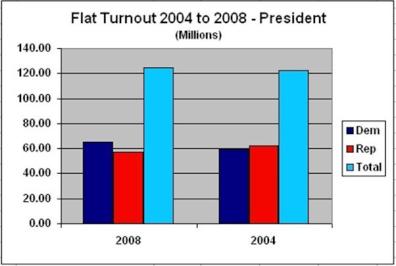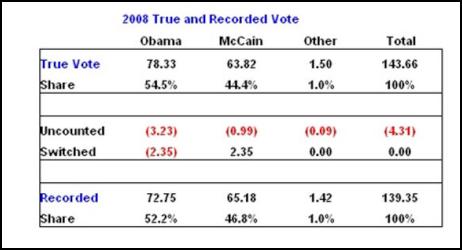2008 Presidential Turnout Flat
How Did That
Happen?
Michael Collins(Wash. DC) In 2004, we were told to anticipate a red versus blue election. It didn't turn out that way but that was hardly mentioned.
By 2008, we were told to expect record voter turnout for the presidential election. Now we're told that the predictions were wrong, the pictures of long lines, massive early voting, and massive registration increases all went to produce just about the same vote total as reported for 2004.
The 2004 vote total was 122 million compared to 105 million in 2000. We're left with this question. With all the excitement and effort plus a huge funding advantage for Obama, how is it that the voters going to the polls were about equal in number for 2004 and 2008?
Here are some of the headlines:
Voter turnout approaches some records, breaks others, Harvard Gazette, Nov. 6, 2008, Thomas E. Patterson, Harvard Kennedy School
"Judging from past experience, however, it would appear that roughly 134 million Americans voted in the 2008 general election - a 65 percent turnout rate."
This estimate is 10 to 12 million votes over the actual count. But that difference is is minor compared to the projection of Infoplease which estimated 148 million voters on Nov. 4, 2008.
Unprecedented Latino Voter Turnout Plays Critical Role in Early Outcome of the Presidential Election, Market Watch Nov. 5, 2008
"In Virginia, where the reported margin of victory as of this writing was 120,299, the NALEO Educational Fund estimates that about 67,000 Latinos voted for Senator Obama. In Florida, where the reported margin of victory as of this writing was 178,745, the NALEO Educational Fund's analysis estimates that about 548,000 Latinos voted for Senator Obama."
The Latino vote surprised the skeptics who claimed that president elect Obama would struggle to motivate these citizens. Clearly he did but their votes were not enough to generate an overall increase according to the final figures.
But look at the turnout figures as actually reported and gathered by David Leip for the Atlas of U.S. Presidential Elections.

Reported vote totals for 2004 and 2008. CNN, Nov. 7, 2008
Check David Leip, Atlas of U.S. Presidential Elections for best cumulative results
over the next few weeks. "Other" candidates (using Leip) incorporated in "Total."
The vote counts are virtually the same for both years. Some ballots remain uncounted. North Carolina has identified 34,000, and Missouri, about 10,000. Many of these are provisional ballots. States average a 20% to 70% count of these special ballots for voters who turned up at the wrong precinct. The only major number of votes left is in California. They report 2.7 million uncounted ballots. The accumulation of these figures represents a 2.5% change. Compare a 3 to 5% turnout increase from 2004 to 2008 with the 16% increase from 2000 to 2004.
All the excitement generated by the campaign, all the efforts, all the controversy generated the very close to the same election figures that we saw in 2004.
Does this make sense? What about the enthusiasm that the Democrats generated in the primaries. Primary voters are highly motivated. They tend to vote in very high numbers in the general election following the primary.
Democratic Primaries: 2008 Primary Turnout More than Doubled 2004 Turnout

The Green Papers: 2008 2004
The 2008 Democratic primaries for 34 states showed 34 million voters, twice as many when compared to 2004. In fact, the difference between the two years, 17.6 million, is greater than the vote total for the same 2004 primaries, 16.1 million.
This enthusiasm was seen in both large and small states.

The Green Papers: 2008 2004
Both 2004 and 2008 were contested primaries but look at these numbers comparing the two years. Increases in new primary voters ranged from 0.8 million to 2.0 million.
The same increases are seen in the smaller states.

The Green Papers: 2008 2004
This primary phenomenon was discussed in some detail in Michael Collins: Election 2008 - The Difficulty Stealing It This Time, Oct. 10, 2008
Where Are The Votes?
What happened? Did the Republicans simply throw in the towel? Did a big portion of those new Democratic primary voters suddenly forget where the polling place was on Nov. 4? Or was it something else?
Instead of using the reported vote total as the basis to measure the polls and the observed events, we should ask the question - was the 2008 vote underreported? Maybe those 34 million primary voters went to the polls and took a friend. More pertinent, maybe the more than doubling of Democratic primary voters in 2008 was a solid indication that election 2008 would produce another major increase in turnout and total votes?
Moving beyond the political logic and common sense, it's well worth considering the analysis offered by internet poster TruthIsAll. He has modeled and analyzed presidential elections non stop from the 2004 campaign through the present. By analyzing the assumptions behind adjustments to the exit polls and other data, he's developed a "True Vote" model with which he predicted the following.

2008 Landslide Denied: Uncounted Votes and the
Final National Exit Poll, TruthIsAll Nov. 5, 2008
Ironically, TruthIsAll's total brings the estimates of Harvard's Thomas Patterson and Infoplease closer to reality.
Whether it’s a common sense approach relying on factors like huge increases in primary Democratic voters or a more scientific approach like that found in TruthIsAll’s analysis, the obvious questions endure. How did all this activity and enthusiasm fail to generate any measurable increase in turnout compared to 2004? How did it get Obama just 3.0 million more votes?
A willingness to question the actual vote count is a very good place to start an inquiry on this unexpected outcome and the claim by those who count the votes that this is all there is? After all, the vote counters and elections officials haven't inspired much confidence over the past eight years.
Permission to reprint all or part of this article with attribution of authorship, a link to this article, and attribution of images where indicated.


 Binoy Kampmark: Foiling Rupert Murdoch - Project Harmony Misfires
Binoy Kampmark: Foiling Rupert Murdoch - Project Harmony Misfires Ian Powell: Commissioner’s Approach To Healthcare Provision - ‘Slash And Burn’
Ian Powell: Commissioner’s Approach To Healthcare Provision - ‘Slash And Burn’ Jack Yan: The Case For Brand Aotearoa
Jack Yan: The Case For Brand Aotearoa Ramzy Baroud: Unity Above Else - The Only Road to the Liberation of Palestine
Ramzy Baroud: Unity Above Else - The Only Road to the Liberation of Palestine Binoy Kampmark: Finding The Unmentionable - Amnesty International, Israel And Genocide
Binoy Kampmark: Finding The Unmentionable - Amnesty International, Israel And Genocide Gordon Campbell: Gordon Campbell On The Government’s Ongoing Ferries Disaster
Gordon Campbell: Gordon Campbell On The Government’s Ongoing Ferries Disaster 